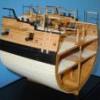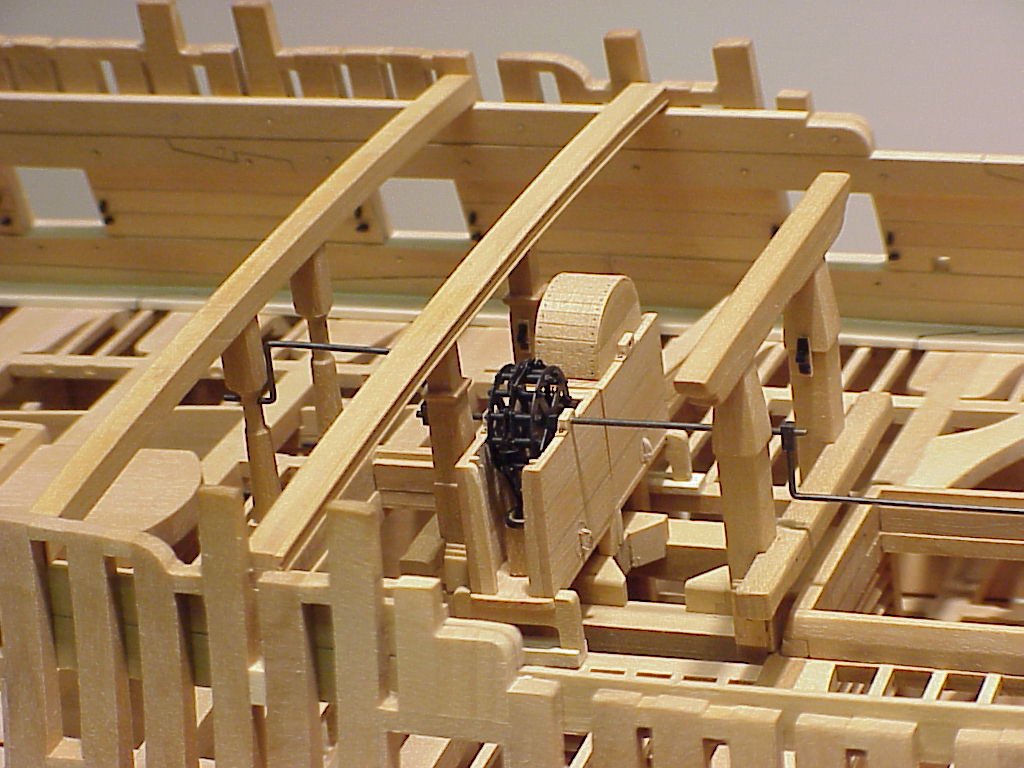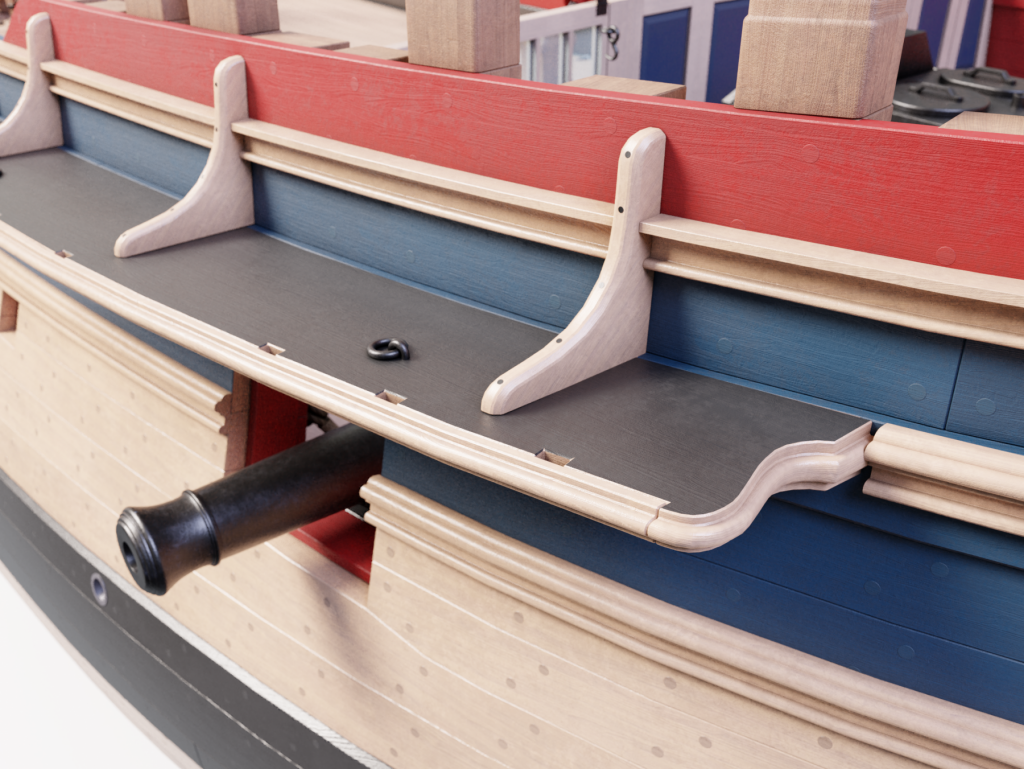-
Posts
2,457 -
Joined
-
Last visited
Content Type
Profiles
Forums
Gallery
Events
Everything posted by dvm27
-
I have had some requests for our discontinued photoetched sheets over the past few years. The sheet is depicted below and was designed for those building a Swan class model at the classic 1:48 scale. They are difficult and expensive to produce but I would be willing to do it one last time if ten individuals commit. They cost $60, plus postage. Included are door hinges, lantern brass housings, horseshoe and dovetail plates and gunport straps. In addition (and the main reason we designed the sheet) included are all the components necessary to build the complicated metal chain pumps (except the brass tubing) that reside within the pump housings. Those of you building a Swan, Echo, Triton or Chuck's new Pegasus cross section may consider purchasing one of these sheets as nothing similar is on the market. If you would like one (or more) of these sheets please send me an e-mail at dvm27@comcast.net. Please do not respond to this post here. This will be the last time these sheets will be produced! It is my impression that Chuck will not be including details of the pump mechanism in his new Pegasus cross-section in order to keep the cost managable.
- 6 replies
-
- swan
- sixth rate
- (and 4 more)
-
Alan, from Figureheads of the Royal Navy, by David Pulvertaft. "Her figurehead was described as the naked figure of the young Greek hero, Bellerophon, riding bareback on the rearing winged horse, Pegasus, wearing a golden helmet with white plumes and a short red cloak flying back from his shoulders." (Citation Edward Fraser, Bellerophon, The Bravest of the Brave, Wells Gardner, Darton and Co, 1909). Didn't know if you have the above reference but thought I'd mention it just in case. So the wings were spread and rearing
-
Just to expand on what Chuck wrote, Camarata's Confederacy model was very well researched and his rig is based on Crother's review of others primary source material, notably Dr. DH Robinson's article and survey of material in the Nautical Research Journal (Volume 8, No. 2). So, I would say Justin's rig is probably pretty close to the original. Perhaps he might be willing to provide you with his plan. Insidently, all the window frames and muntins were photoetched. That's why they look so perfect.
-
Hey guys - this forum is supposed to be in English. What language are you speaking?
-
Just curious, Ed. Did clipper ships ever have stanchions or railings on the tops like navy vessels? Looks like one could easily fall off the aft top, especially when wet or dark!
- 3,618 replies
-
- young america
- clipper
-
(and 1 more)
Tagged with:
-

HMS VICTORY 1759 by isalbert
dvm27 replied to isalbert's topic in - Build logs for subjects built 1751 - 1800
Tres bien fait! -
Looks terrific, Mike. I also prefer the boxwood but understand the economics of offering the kit in cherry.
- 607 replies
-
- winchelsea
- Syren Ship Model Company
-
(and 1 more)
Tagged with:
-
Chris, no matter how good your work looks now you'll want to replace it six months down the road. There's a definite learning curve here but you've made a good start. I find that what helps me a lot is to wear 5x loops when doing any joints. I use them not only because I have extra crappy vision but I find that if I am happy with a joint made under magnification it looks really good without them. That's an adorable puppy. By the time you've finished your model she'll have tumors, osteoarthritis, glaucoma and bad breath.
-

ancre Chebece 1750 by Jeronimo - FINISHED
dvm27 replied to Jeronimo's topic in - Build logs for subjects built 1501 - 1750
Wonderful work, Karl. I would of thought it would be easier to plank around those gratings then cut the openings later but you've done a perfect job. -

Echo by tlevine - FINISHED - Cross-Section
dvm27 replied to tlevine's topic in - Build logs for subjects built 1751 - 1800
Very nice job, Toni. I think you'll find the cross-section a pleasant diversion from the fully framed model. Those scupper insets look spot on.- 52 replies
-
Afraid not Azzoun. Those, like everything else in that photo, are computer renderings.
- 130 replies
-
Positive frame registration top and bottom will make it very hard to screw up. This is a very innovative concept, Chuck! And how lucky to have a willing group of testors come to your house.
- 130 replies
-
And that's how one achieves a perfect joint! It all start's with a perfect pattern. Love watching you work, Amalio.
-
Lovely work, Mike. There's something about this hull that has always appealed to me. Lot's of planking ahead!
- 607 replies
-
- winchelsea
- Syren Ship Model Company
-
(and 1 more)
Tagged with:
-
For those who wish to mask , spar, and rig their ship You could always buy the plan we get for the few left. I got to tell you though that you will be changing your case from perhaps 8“ x 8” x 8” to 8“ x 25“ x 30+ inches! Pegasus transforms from that cute little desktop case to awkward object
- 130 replies
-
When Chuck's creative mind is unleashed all sort of innovative ideas spew forth. Think of this cross-section as a diversion from your current multi-year build. In just a month or so you'll have a beautiful desk top model and you will return to your current project with renewed enthusiasm.
- 130 replies
-
Each layer just makes the model look cooler and cooler, Dan!
- 287 replies
-
- michelangelo
- ocean liner
-
(and 1 more)
Tagged with:
-

Swan class 3D model in progress
dvm27 replied to dvm27's topic in CAD and 3D Modelling/Drafting Plans with Software
Just to be clear this is the work of Denis Rakaric, on behalf of Admiralty Models. I believe his work ranks among the best in the world!- 141 replies
-
- pof swan series
- swan
-
(and 1 more)
Tagged with:
-
I got the Porter Cable hot air gun off Amazon. It was somewhere around $35. I shape the plank off the model by applying heat wherever required to get the twist and bend I need. Just keep gentle shaping, offer up to model to assess then add more heat where bend or twist is still needed. It's quite therapeutic because your're shaping it to the hull and not relying on clamps and soaking to massage it into place. When finished, I don't need clamps to secure the plank; just glue and 90 seconds of finger pressure (I still use clamps after it appears set, though, just to be sure there is maximum adhesion throughout the entire plank). Extreme bends at one end can be done by using a pair of pliers to facilitate the curve under heat On caveat - the hot air gun is...hot!!! As Fire Safety Engineer Kurt has pointed out it can burn wood or flesh quite easily. I can attest to smokey gloves when first learning to use it.
-
Darn it , Mark. I just encountered the exact same problem and your solution seems to do the trick. I assume you removed the yellow rubber insets to extend the width of the clamp? Have you tried a hot air gun? I'm achieving twists and bends I thought were impossible before. No more overnight clamping of wet wood for me! Look at this beautiful piece of 1/8" boxwood I ruined while experimenting with the hot air gun the first day I received it. That was a month ago and the shape is exactly the same.
-

Pandora by marsalv - FINISHED - 1:52
dvm27 replied to marsalv's topic in - Build logs for subjects built 1751 - 1800
Lovely work Marsalv! I'm trying to envision how you fished that collar under the bowsprit with all those other elements in place!
About us
Modelshipworld - Advancing Ship Modeling through Research
SSL Secured
Your security is important for us so this Website is SSL-Secured
NRG Mailing Address
Nautical Research Guild
237 South Lincoln Street
Westmont IL, 60559-1917
Model Ship World ® and the MSW logo are Registered Trademarks, and belong to the Nautical Research Guild (United States Patent and Trademark Office: No. 6,929,264 & No. 6,929,274, registered Dec. 20, 2022)
Helpful Links
About the NRG
If you enjoy building ship models that are historically accurate as well as beautiful, then The Nautical Research Guild (NRG) is just right for you.
The Guild is a non-profit educational organization whose mission is to “Advance Ship Modeling Through Research”. We provide support to our members in their efforts to raise the quality of their model ships.
The Nautical Research Guild has published our world-renowned quarterly magazine, The Nautical Research Journal, since 1955. The pages of the Journal are full of articles by accomplished ship modelers who show you how they create those exquisite details on their models, and by maritime historians who show you the correct details to build. The Journal is available in both print and digital editions. Go to the NRG web site (www.thenrg.org) to download a complimentary digital copy of the Journal. The NRG also publishes plan sets, books and compilations of back issues of the Journal and the former Ships in Scale and Model Ship Builder magazines.






